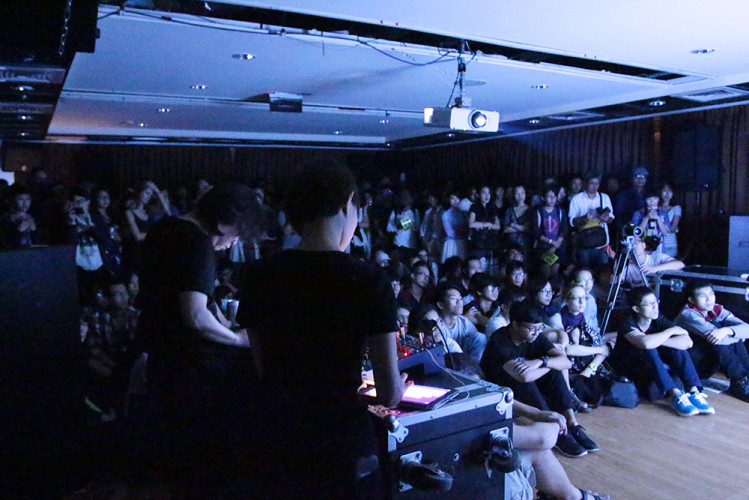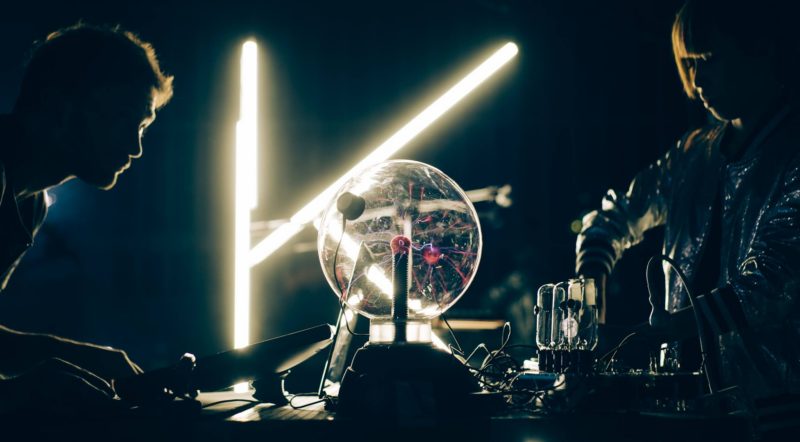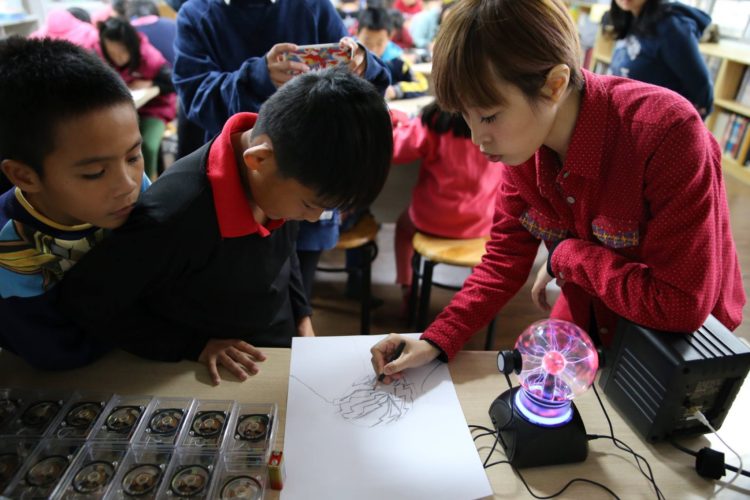➤行政與創作雙軌的聲響發現之路(洪瑞薇(訪談/整理) – 2017.03.16)
Her Double-tracked Journey of Acoustic Discovery as Arts Administrator and Artist(HUNG, Jui-wei (Interview/Text) – 2017.03.16)
Fly Global(以下簡稱FG):妳原是一個國小流浪教師,後來轉任藝術行政,甚至有了自己獨立的創作發展,這樣的轉變是如何發生的?
盧藝(以下簡稱盧):我生長在一個非常保守的家庭,家族成員幾乎都是公教背景,我也以謀得一份安穩的教職為當然目標。畢業後碰上了台灣嚴重的流浪教師問題,我輾轉於小學短期代課,在沒有穩定教職的情況下,我去念了應用藝術研究所、到臺北藝術大學藝術與科技中心擔任助理、又到舊金山進修語言和藝術課程,種種人事物的衝擊讓我的內心出現轉變,想走一條想像之外的、不那麼乖的人生路。
在那個自我猶疑的時期,聽聞聲音藝術家王福瑞想找個行政助理,我感覺那也許正是我所需要的刺激,於是爭取了這份工作,那是2011年。之後我們開始以「響相工作室」為名,努力推動台灣與國際的聲音藝術相關計畫。
2014年在台北國際藝術村的「混種現場」我第一次嘗試登台表演,幫福瑞操控即時視覺,在演出中我體會到一種腦內分泌多巴胺的感受,那愉悅使人上癮,我們在後來的國際巡演延續了這樣的模式。2015年在倫敦的「射殺鋼琴師:台北噪音場景 1990-1995」展,策展人游崴邀請我為開幕做演出,那是我初次獨立聲音表演。
Fly Global: You were once a “vagrant teacher”, later an arts administrator and now an independent artist. How did all these changes come about?
Lu Yi: I grew up in a very conservative family. Most of the members are either public servants or teachers. Therefore, getting a stable teaching job became my undisputed goal of life. By the time I finished college, the problem of “vagrant teacher” was most rampant in Taiwan. I worked as a short-term substitute teacher from one elementary school to another. Since I never settled down on one job, I enrolled myself in a graduate program studying applied arts. In the meantime, I worked as an assistant at the Center for Art and Technology at TNUA and took language and art courses in San Francisco, USA. These circumstances brought internal changes within me. I realized I wanted to choose an unexpected and unorthodox path of life.
As I was weighing my options, I heard sound artist Wang Fujui was looking for an administrative assistant. I thought, “This could be the stimulus I need”, so I applied for the job. It was in 2011. Since then, under the name of Soundwatch Studio, Wang and I have been promoting Taiwanese and overseas sound art projects.
My stage debut was in 2014, when I helped Wang with real-time visuals at on site 2014 at Taipei Artist Village. During the performance, I could feel the release of dopamine running through my brain. It is a kind of pleasure one can get addicted to. We went on with the same mode of collaboration in the following overseas tour. In 2015, at the exhibition Shoot the Pianist – The Noise Scene in Taipei 1990-1995, I participated in the opening performance upon the invitation of curator Yu Wei. It was my first solo sound performance.
FG:從行政人過渡到創作者的轉換過程中是否有需要調適的地方?
盧:跨入這個領域工作之初,我其實不太懂什麼是到位的聲音表演,一開始用的笨方法是偷瞄福瑞的表情,我也會記下他與我分享的喜愛的作品。起初這麼做只是單純想抓住老闆的喜好,讓工作可以更順利進行,五年下來逐漸吸收、轉化成為我對聲音表演的體悟。台灣的相關領域中有許多熱血的創作人,頻繁地接觸到這樣的人,感受到他們創作時的喜悅,慢慢的自己也產生了嚮往。
從事創作時偶爾會接收到「妳太行政了」這類的提醒,做為行政習慣考慮得比藝術家還要周到,加上我曾在當代藝術館工讀,處理展務的經驗讓我特別會關照到藝術家以外的、譬如觀眾的視角。這或許也有好處,但過多了會產生限制,因此創作的時候我經常提醒自己丟掉行政的腦袋,多一點開放和自由。
FG: Transitioning from an administrator to an artist, what adaptations did you make?
Lu: When I first stepped into the field, I had no clue what “good” means in sound performance. At first, I would see how Wang reacted by peeking at his facial expressions. I also took notice of the works which he had said he was fond of. My initial intention was to find out the preferences of my boss (Wang) to make my job easier. But over the past five years, I’ve learned a lot from him. I internalized the know-how and developed my unique understanding of sound performance. I’ve met many ambitious Taiwanese artists in related fields. As I interacted with them frequently, I felt their joy working as artists. Gradually, my passion for the arts grew.
As an artist, I was sometimes told, “you are being too bureaucratic!” Indeed, my administrative experience taught me to be meticulous about everything. Besides, I was once a part-time assistant at the Museum of Contemporary Art Taipei. As my job involved event management, I learned to care about the needs of the people other than artists, for instance, the audience’s viewpoint. This could be a good trait to have. However, overthinking normally creates limits for an artist. So now when I’m creating, I often tell myself to get rid of the administrative brain and embrace more openness and freedom.
FG:近兩年妳與法國視覺設計師Sébastien Labrunie展開合作,在「超聲波」等台灣的聲音展演平台演出,請分享你們的創作探索。
盧:初嘗創作之際,我偶然結識了來自法國的視覺設計師Sébastien Labrunie,發現彼此有很多共通的話題,很想一起做點什麼。後來福瑞籌辦「超聲波」,希望提供新人一個新的聲音藝術展演平台,於是我和Séb組了一個叫「Sondes」的團參加演出,名字的意義是「電波接收器」。
Séb近兩年熱衷於一種全新的視覺技術,可使影像兼具身歷其境、三維與動作感,並藉由控制器與身體動作同步。他將他的新發現運用在我們的表演中,帶來了更具生命力的聲影互動可能。我的聲音創作提供了Séb一種簡潔與對比的視覺靈感,所以他選擇了以黑白律動的線條、對稱的手法,搭配我的聲響即時創造出具有有機感的畫面。
「超聲波」之後我們也參與了「白晝之夜」、「大內藝術聲響之夜」、「失聲祭」等台灣的聲音展演平台。我們仍在持續開發新的可能,未來希望運用Séb所熟悉的一款VR音樂軟體「Lyra VR」共同創作,也希望發行屬於自己的唱片專輯。
FG: Over the past two years, you have worked with French visual designer Sébastien Labrunie in Hypersonic and other sound performance platforms. Tell us about your artistic exploration with him.
Lu: During my early days as an artist, I met Sébastien Labrunie by chance. We felt we had a good connection and wanted to do something together. Later, Wang Fujui founded Hypersonic, which was a performance platform for new sound artists. Séb and I decided to go for it. We formed a group called Sondes, which means “electric wave receiver”.
Over the past two years, Séb has been experimenting with a whole new visual technology. The technology not only makes videos look immersive, 3D and kinetic, but also enables synchronous movement between visuals and performers with the use of controllers. He applied his new discoveries to our joint performance and created some genuine audio-visual interactions. My sound arts provided Séb with concise and contrastive visuals. In the end, he chose to present his art in symmetrical black-and-white stripes to go with mine and the result was a performance with an organic feel.
Following Hypersonic, we performed at Generate the night, TAD After Party, Lacking Sound Festival: Listen and other platforms. We continue to search for new possibilities, one of which could involve the use of Lyra VR, a VR sound software application that Séb is familiar with, in the creative process. We also hope to release our own album.
FG:妳曾開發過一些聲音裝置,也運用其中的基礎元件開設過許多聲音藝術工作坊,請談談妳在這方面的參與。
盧:我使用聲音取樣混種、手工自製電子樂器、電路擾動、硬體駭客和類比錯誤聲響等進行創作,這是長期與福瑞共事後,很自然的承襲自他的方法。我們也經常一起到處發現可以拿來改造、創造聲響的東西。
譬如《時電聲態》這件聲音裝置,核心是Atari Punk Console這套源自80年代遊戲主機的電路結構,我從福瑞那裡學會如何焊接電路及搭配電容等知識,然後再加入自己對當下生活的感受,把它改造成時鐘的樣子,讓它發出既受規律約束,但又擾動隨機的狀態。當時因為忙碌身心失序,但在工作上又得準確跟上行程,導致了某種「時差」;此外我對「噪音」也有相似的感受,它既是一種紛亂的錯誤能量,但又像是自我嚮往原始平衡的正向追尋,這些矛盾促成了這件作品。
我也運用這套電路結構在台北當代藝術館展開了我的第一次工作坊,原本只是代替福瑞上場,結果促成了後續的臺灣科學教育館等邀約。近兩年我也和立賢教育基金會合作,到過20所偏鄉小學提供聲音創作體驗課。教學工作坊結合了我先前的教育背景,且能運用我在聲音領域發現的新知,我也曾將工作坊中的拾音器,改良運用在後來的表演中。譬如我在「Sondes」演出中所使用的離子球,可以隨著聲音或手勢產生很棒的視覺效果。
FG: You have developed several sound devices and demonstrated some of the basic components at workshops. Tell us about those endeavors.
Lu: I create sound arts by using sound sampling, home-made electronic instruments, circuit bending, hardware hackers and analog errors. After spending years with Wang Fujui, I tend to follow his techniques. We also look for things that can be remodified to make sounds.
Take the sound installation Time Electric Sound State for example: The core component is an Atari Punk Console, which was named after a game console popular in the 1980s. Wang taught me about circuit welding and capacitance. I decided to modify the circuit into a clock-like object because that was how I felt about my life at that time. The sounds of the installation were both patterned and disturbingly random. The idea was mimic the “jetlagged state” that I found myself in back in those days: trying to be on schedule while being physically and mentally exhausted from work. I have the same mixed feelings about noise, which I see as a chaotic energy of error, but also a positive gateway to achieving natural equilibrium. These contradictions helped materialize the installation.
中文Chinese:
http://www.flyglobal.tw/zh/article-476
英文English:
http://www.flyglobal.tw/en/article-476



